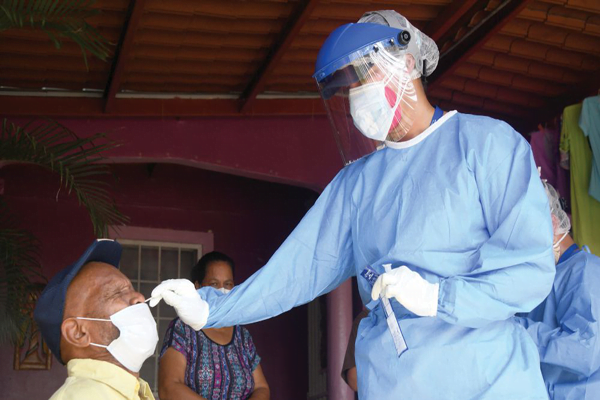New strains of SARS-CoV-2 and the increase in cases in Panama
*by Dr. José R. Loaiza
Since its appearance on the global scene, the SARS-CoV-2 coronavirus acts as a silent serial killer on the run. And as detectives, scientists are on their trail, but their movements are difficult to predict because it is constantly changing.
The verdict on this defendant is not easy to deliver or sentence, because the scientific evidence is debated in real time and is not clear or definitive to establish the precise outcome of the crime.
To understand this complicated crime scene, detectives must analyze from different angles and maintain an open discussion posture. This, translated in terms of the Covid-19 pandemic, means that scientists must investigate the evolution of SARS-CoV-2 using different methodologies and conceptual approaches.
A natural mistake, neither bad nor wrong
Let’s talk about mutations in a virus. The first thing is to understand that a mutation is not necessarily bad or wrong, but that it occurs naturally during the life of the virus as a result of a process of reproduction with errors, which increases its chances of success to persist and spread.
In the long term, this process is related to a decrease in the severity of the disease and a more effective spread. That is, SARS-CoV-2 mutates into different variants to cause less damage and maximize its silent dispersal.
The beginnings of this pandemic plot are indecipherable and complex. Two variants emerged from the original virus that caused the epidemic in Wuhan, China. The first is D614G, which was detected in China in early 2020, and the second is VOC 202012/01, which was detected in the UK in September 2020.
Both have powerfully attracted the attention of scientists, because they have amino acid changes in the spike protein, which plays an important role in the invasion of the virus into the cell, and for which we try to generate antibodies through different vaccines. But how do you decipher which is the most contagious and if there are real differences in its levels of transmission from person to person?
Hypothesis
One of the theories raised by some scientists to explain the recent increase in the number of Covid-19 infections in Panama is the existence of new viral variants that have a higher degree of transmissibility; that is, they are more contagious from person to person or more infectious at the cell level, compared to other variants of the virus.
This conclusion stems from a gradual increase in the frequency of occurrence of these variants in the population, since their initial detection. Which means that in recent months, a large proportion of people infected with SARS-CoV-2 in the country carry some of these new variants.
SARS-CoV-2 travels through the air in tiny aerosol droplets. Viral particles are shed by infected people when they breathe, speak, cough or sneeze. An infected person can be asymptomatic and still be contagious, expelling multiple variants of SARS-CoV-2. And like a highway stowaway, the virus mounts the responsive host, who will give it the most discreet ride to its next victim.
One of the main suspects is the D614G variant, which has an evolutionary advantage over other variants that allows it to increase its frequency of occurrence in the population through the process known as Sweep Selection. That is, this variant could have a greater capacity to infect and replicate in the cells of young asymptomatic people. These people quietly spread the variant, because they go unnoticed by escaping epidemiological surveillance for people with Covid-19 symptoms. Therefore, this D614G variant increased its frequency of occurrence significantly in Europe and spread throughout the rest of the world, including the American continent.
In Panama, the D614G variant was detected in March 2020. In fact, the first genome sequenced in our country was a representative that contained the mutations of this variant, suggesting that Panama was not colonized by the original SARS-CoV-2 variant. Not surprisingly, the D614G variant has a high proportion in the Panamanian population. It has had more than nine months to quietly spread nationally.
‘Quasispecies’, competing variants
This contradicts the notion that, during a completely random virus spreading event, there are variants that are most contagious or transmissible from person to person, among the many variants that are exhaled by infected people. In fact, only some of the exhaled variants end up infecting a healthy person, and these few variants begin to compete for space and resources within their new host, in a process known as the Founder Effect.
It is also possible that the variant of SARS-CoV-2 that is sequenced from nasal swab samples is different from the one that is reproducing in the lower respiratory tract, including organs such as the lungs, which makes it difficult to establish associations between variants of the virus. and the level of cellular infectivity or the degree of transmissibility or severity of the disease.
Super propagators
On the other hand, it is well known that some people infected with SARS-CoV-2 are more efficient than others in spreading the virus from person to person.
Studies indicate that 80% of new infections are due to 10% of people who carry the virus. The probability that these super-spreading individuals carry and spread the same genomic variant of the virus, to healthy people, is low.
The combination and strictly random nature of the Founder Effect of “Quasispecies” and the super-spread events are not consistent with the hypothesis that the increase in the number of SARS-CoV-2 infections in Panama is due to new variants of the viruses that are most contagious from person to person.
From the results obtained to date, it is also deduced that the massive agglomerations of people that occurred in the country, between November and December 2020, could have substantially increased the probabilities that super-spreaders have infected a large number of individuals healthy, agglutinated in the most densely populated regions of Panama.
Likewise, the possibility that some children innocently become infected without showing symptoms of Covid-19 and transmit the virus to their parents or grandparents in family gatherings is real.
The country should invest in basic and applied scientific research to strengthen genomic, epidemiological and community surveillance protocols. This will allow us to understand how changes in the genome of deadly pathogens such as SARS-CoV-2 impact their person-to-person transmission, pathogenicity, and virulence.
It will also be necessary to work interdisciplinary closing the gap between the natural and social sciences, to understand the role of human behavior in the evolution and successful spread of the virus.



Leave a Reply